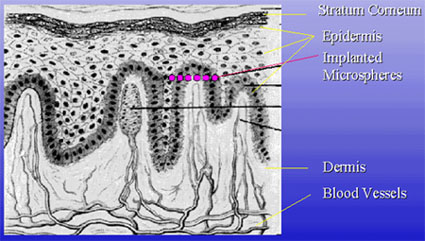Analyte Detection Using Fluorescence
Background
In our approach, we are working with the faculty in the Chemical Engineering Biomaterials group to develop unique polyethylene glycol hydrogel microspheres, composed mostly of water which are nontoxic and hydrophilic. This makes the implant resistant to protein adsorption, the major mediating mechanism of host response to material implantation. Permeability of the spheres is controlled by the hydrogel composition. By changing the molecular weight cutoff of the fluorescence sensor, species of interest may diffuse into and out of the polymer network while high molecular weight fluorescent-labeled compounds are restricted to the polymer domain.
Using two fluorescent dyes in a fluorescence resonance energy transfer mode (FRET), the lab is attempting to prove that these polymer-encapsulated fluorophores can indicate glucose levels. In the presence of glucose, a solution containing fluorophore labeled Dextran and a separate fluorophore labeled concanavalin-A (Con-A) dual fluorescence peaks can be seen as depicted in the spectra below. This is due to the competitive binding occurring between the dextran and glucose for the Con A and the glucose that displaces the dextran molecules. In the absence of glucose, one fluorophore absorbs the fluorescence emission that the other produces.
 |
|
Fluorescence
Spectra
|
Two different encapsulation methods, calcium alginate gels coated with poly-L-lysine (CA-PLL) and photopolymerized polyethylene glycol (PEG) hydrogels, have proven to be highly swollen with water and, as a result, highly permeable to glucose. The gel network also prevents the loss of Con-A and dextran.
This research aims to develop microspheres containing the assay mentioned above to be injected near the epidermal-dermal junction to interact with the interstitial fluid in an implant we refer to as a "smart tattoo".
 |
|
Skin Structure:
A layer
of spheres representing the sensors are pictured between the
epidermis and dermis.
|
REFERENCE
Russell, R., Pishko, M., Gefrides, C., McShane, M.J., and Coté, G.L., "A fluorescence-based glucose biosensor using concanavalin A and dextran encapsulated in poly 9ethylene glycol) hydrogel", Analytical Chemistry, Submitted January 1999.
McNichols, R.J., and Coté, G.L., "Optical Glucose Sensing in Biological Fluids: An Overview", J. Biomedical Optics, Submitted January 1999.
McShane, M.J., Rastegar, S., Pishko, M., and Coté, G.L., "Monte Carlo Modeling For Implantable Fluorescent Analyte Sensors", IEEE TBME, Submitted December 1998.
Coté, G.L., Noninvasive Optical Glucose Sensing-An Overview, J. of Clinical Engineering. V22, N4, pp. 253- 59: July/August 1997.
Department of Biomedical Engineering | Dwight Look College of Engineering | Texas A&M University